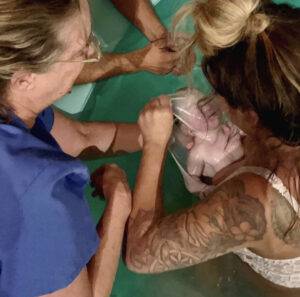 In early pregnancy, the baby experiences the womb as an ocean of warm amniotic fluid. The size of the watery womb is vast compared to the size of the baby. Gradually, as the baby grows, the amniotic ocean shrinks into mere pockets of insulation around the baby.
In early pregnancy, the baby experiences the womb as an ocean of warm amniotic fluid. The size of the watery womb is vast compared to the size of the baby. Gradually, as the baby grows, the amniotic ocean shrinks into mere pockets of insulation around the baby.
During labor, waves of uterine contractions mimic the waves of an ocean swell that arrive gently and infrequently at first, but build in frequency, size and power. The mother and baby ride the waves together to birth the baby.
One can imagine that being born into a pool of warm water may momentarily ease the baby’s transition from the warm, watery womb to the cooler air environment of the extra-uterine world.
There are many studies in the scientific literature to prove that waterbirth is safe. Air on skin is the stimulus to breathe. While underwater the baby is not stimulated yet by air and does not draw the first breath until he/she emerges from the water.
San Diego hospitals do not permit birthing in water.
Let us place the infant, replace it rather, into water!
For the baby has emerged from water, the maternal waters that have carried it, caressed and cradled it. Made it light as a bird…
A bath has been prepared in a basin. At the temperature of the body or thereabouts-ninety-eight or ninety-nine degrees.
We place the child in it.
Once again, extremely slowly.
As the baby sinks down, it becomes weightless, and is set free of the body that is overwhelming it- the body with all its burden of harsh new sensation.
The infant floats. Disembodied. Light. As free as in the early, distant days of pregnancy, when it could play, could move about without restrictions in a limitless sea.
It’s surprise, its joy are boundless.
In its element once more, the infant forgets what it has just left behind: forgets its mother. It has returned inside her
~ Frederick Leboyer


